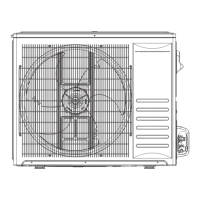Safety Summary
Important notice
• We pursue a policy of continuing improvement in design and performance of products. The
right is therefore reserved to vary specifications without notice.
• We cannot anticipate every possible circumstance that might involve a potential hazard.
• This air conditioner is designed for standard air conditioning only. Do not use this air
conditioner for other purposes such as drying clothes, refrigerating foods or for any other
cooling process. Do not let the air-out face animals or plants, it might have an adverse effect
on them.
• The installer and system specialist shall secure safety against leakage according to local
regulations or standards.
• Signal words (DANGER, WARNING and CAUTION) are used to identify levels of hazard
seriousness.
Definitions for identifying hazard levels are provided below with their respective signal
words.
• Installation should be performed by the dealer or other professional personnel. Improper
installation may cause water leakage, electrical shock, or fire.
• Do not perform installation work, refrigerant piping work, drain piping and electrical wiring
connection without referring to our installation manual. If the instructions are not followed, it
may result in water leakage, electric shock or fire.
• Use refrigerant R410A in the refrigerant cycle.
• Do not pour water into the indoor or outdoor unit. These products are equipped with electrical
parts. If poured, it will cause a serious electrical shock.
• Do not open the service cover or access panel for the indoor or outdoor units without turning
OFF the main power supply.
• Do not touch or adjust safety devices inside the indoor or outdoor units. If these devices are
touched or readjusted, it may cause a serious accident.
• Refrigerant leakage can cause difficulty in breathing due to insufficient air. Turn OFF the
main switch, extinguish any naked flames and contact your service contractor, if refrigerant
leakage occurs.
• Do perform air-tight test. Do not charge oxygen, acetylene or other flammable and poisonous
gas into the refrigerant cycle when performing a leakage test or an air-tight test. These types
of gas are extremely dangerous and can cause an explosion. It is recommended that nitrogen
be used for this test.
• The installer and system specialist shall secure safety against refrigerant leakage according
to local regulations or standards.
• Use an ELB (Electric Leakage Breaker). In the event of a fault, there is danger of an electric
shock or a fire if it is not used.
Immediate hazards which WILL result in severe personal injury or death..
Hazards or unsafe practices which COULD result in severe personal injury
or death.
Hazards or unsafe practices which COULD result in minor personal injury
or product or property damage.
Useful information for operation and/or maintenance.
DANGER
DANGER
WARNING
CAUTION
NOTE

